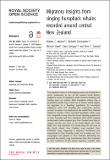Files in this item
Migratory insights from singing humpback whales recorded around central New Zealand
Item metadata
| dc.contributor.author | Warren, Victoria E. | |
| dc.contributor.author | Constantine, Rochelle | |
| dc.contributor.author | Noad, Michael | |
| dc.contributor.author | Garrigue, Claire | |
| dc.contributor.author | Garland, Ellen C. | |
| dc.date.accessioned | 2020-11-20T12:30:08Z | |
| dc.date.available | 2020-11-20T12:30:08Z | |
| dc.date.issued | 2020-11-18 | |
| dc.identifier | 270909059 | |
| dc.identifier | 84a6361f-f083-426a-b733-83a1f008d64e | |
| dc.identifier | 85097930700 | |
| dc.identifier | 000595467400001 | |
| dc.identifier.citation | Warren , V E , Constantine , R , Noad , M , Garrigue , C & Garland , E C 2020 , ' Migratory insights from singing humpback whales recorded around central New Zealand ' , Royal Society Open Science , vol. 7 , no. 11 , 201084 . https://doi.org/10.1098/rsos.201084 | en |
| dc.identifier.issn | 2054-5703 | |
| dc.identifier.other | ORCID: /0000-0002-8240-1267/work/83889606 | |
| dc.identifier.uri | https://hdl.handle.net/10023/21022 | |
| dc.description | Funding: VEW is funded by a University of Auckland Doctoral Scholarship and the Woodside Marine Mammal Research Grant awarded by Woodside Energy. ECG is funded by a Royal Society University Research Fellowship. | en |
| dc.description.abstract | The migration routes of wide-ranging species can be difficult to study, particularly at sea. In the western South Pacific, migratory routes of humpback whales between breeding and feeding areas are unclear. Male humpback whales sing a population-specific song, which can be used to match singers on migration to a breeding population. To investigate migratory routes and breeding area connections, passive acoustic recorders were deployed in the central New Zealand migratory corridor (2016); recorded humpback whale song was compared to song from the closest breeding populations of East Australia and New Caledonia (2015-2017). Singing northbound whales migrated past New Zealand from June to August via the east coast of the South Island and Cook Strait. Few song detections were made along the east coast of the North Island. New Zealand song matched New Caledonia song, suggesting a migratory destination, but connectivity to East Australia could not be ruled out. Two song types were present in New Zealand, illustrating the potential for easterly song transmission from East Australia to New Caledonia in this shared migratory corridor. This study enhances our understanding of western South Pacific humpback whale breeding population connectivity, and provides novel insights into the dynamic transmission of song culture. | |
| dc.format.extent | 15 | |
| dc.format.extent | 1125193 | |
| dc.language.iso | eng | |
| dc.relation.ispartof | Royal Society Open Science | en |
| dc.subject | Passive acoustic monitoring | en |
| dc.subject | Cultural transmission | en |
| dc.subject | Humpback whale | en |
| dc.subject | Migration | en |
| dc.subject | Vocal learning | en |
| dc.subject | QH301 Biology | en |
| dc.subject | DAS | en |
| dc.subject.lcc | QH301 | en |
| dc.title | Migratory insights from singing humpback whales recorded around central New Zealand | en |
| dc.type | Journal article | en |
| dc.contributor.sponsor | The Royal Society | en |
| dc.contributor.institution | University of St Andrews. Centre for Biological Diversity | en |
| dc.contributor.institution | University of St Andrews. Centre for Social Learning & Cognitive Evolution | en |
| dc.contributor.institution | University of St Andrews. Sea Mammal Research Unit | en |
| dc.contributor.institution | University of St Andrews. School of Biology | en |
| dc.identifier.doi | https://doi.org/10.1098/rsos.201084 | |
| dc.description.status | Peer reviewed | en |
| dc.identifier.url | https://doi.org/10.6084/m9.figshare.c.5205260 | en |
| dc.identifier.grantnumber | RGF/R1/180038 | en |
This item appears in the following Collection(s)
Items in the St Andrews Research Repository are protected by copyright, with all rights reserved, unless otherwise indicated.

